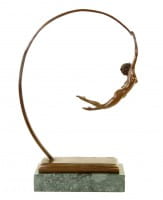Patina
Patina refers to the thin layer that variously forms on the surface of stone, metal, wood, or other materials over a period of time. This natural aging process can result from exposure to the elements, use, or chemical processes. The term is most often applied to bronze or copper sculptures, but can also refer to other materials. Here are some key points about patina:
- Natural Patina: Over time, exposure to oxygen and environmental elements can cause metals to undergo a process called oxidation. This can result in a greenish-blue layer on the surface of bronze or copper, known as a patina. This natural patina is often considered desirable because it can add character and an antique look to the piece. It also acts as a protective layer, preventing further corrosion.
- Artificial Patina: Sculptors and restorers can also induce patina artificially, using chemicals to accelerate the oxidation process. This technique, known as patination, allows artists to add color and texture to their work. The chemicals used in this process can create a wide range of colors, from greens and blues to browns and blacks.
- Care and Maintenance: While patina can protect the underlying metal from further corrosion, it's important to maintain it properly. Improper cleaning can damage the patina and the artwork. Specialized cleaning solutions and techniques are used to preserve the patina while removing dirt and grime.
- Aesthetic Appeal: Many people appreciate the aesthetic value of patina, which can add depth, interest, and a sense of age or history to a piece. It can highlight the texture of a sculpture and give it a unique, weathered appearance. In the art market, a well-developed patina can increase the value of an artwork.
- Patina in Other Materials: While most commonly associated with metal, the term "patina" can also refer to the sheen on wooden furniture produced by age, wear, and polishing, or any similar acquired change of a surface through age and exposure.
In summary, patina is a natural or artificially induced film on the surface of a material, often seen as a mark of authenticity and age. In sculpture, particularly bronze sculpture, a patina can provide color, texture, and a sense of history.


















































